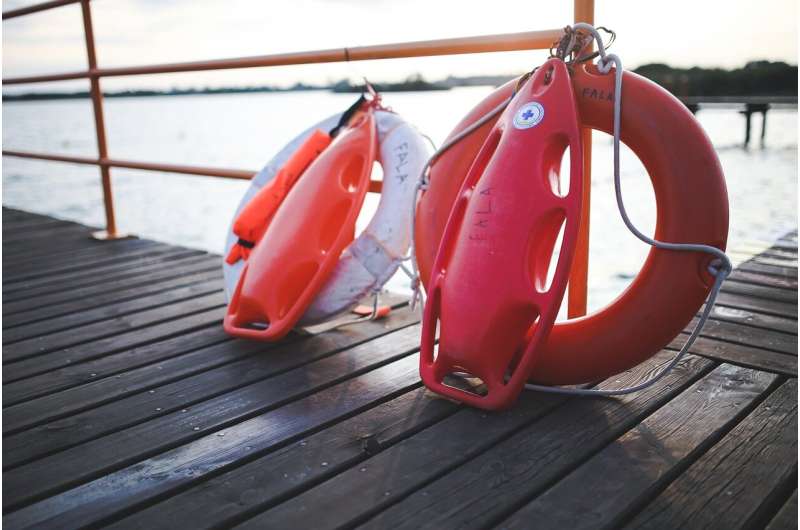This article has been reviewed according to Science X's editorial process and policies. Editors have highlighted the following attributes while ensuring the content's credibility:
fact-checked
trusted source
written by researcher(s)
proofread
Why so many people drown at the water's edge

Just being near blue spaces (the sea, rivers and lakes) can make us feel more relaxed because water triggers our parasympathetic nervous system, helping our body rest and digest. This calming effect, which slows our heart rate and lowers blood pressure, explains why so many people find joy and solace in water-related activities.
But enjoying the water also has serious risks that can't be ignored. In the UK, drowning is a leading cause of accidental deaths, surpassing even home fires and cycling accidents. Each year, around 400 people drown accidentally in the UK's coastal and inland waters.
Notably, 40% of these incidents occur when people aren't even planning to be in the water, such as when they're caught off guard by a rising tide while walking along the coast or jumping in to rescue a dog. This is a glaring reminder that it isn't just traditional water users who get into danger.
According to the Royal Society for the Prevention of Accidents, there are over 100,000 water rescues each year. These rescues are tragedies that leave a lasting impact, with survivors (and their families) often suffering from severe injuries or post-traumatic stress disorder.
Incident report data tells us that globally, men are 80% more likely to drown than women, especially middle-aged men and teenage boys. This higher risk is attributed to men spending more time in the water and engaging in riskier behaviors like swimming alone, at night, drinking alcohol, and neglecting life jackets. Social pressures and a tendency to underestimate risks (by assuming the water looks safe when it isn't) contribute to the higher drowning rates among men too.
My team of neuroscience and communication academics at Bournemouth University are working with the Royal National Lifeboat Institution to research how to improve water safety communications using virtual reality simulations to record brain activities when immersed in water.
By using emotional sensors in smart glasses, we're discovering how emotional loads, like fear, are experienced during virtual reality scenarios, when falling into water unexpectedly from a boat or cliff. We'll be demonstrating the technology at an exhibition at Bournemouth University during August 2024 to highlight the risks of being near water and to collect more data.
So far, our research has highlighted the challenges and complexities of human emotions in making safer decisions in the water and the role that instinct plays in decision making in respect to gender. Men seem to exhibit a different perception of risk and a tendency towards impulsive decision-making, whereas women tend to be more precautionary and a greater inclination towards safety and risk avoidance.
Activities also affect the risk in the water. People tend to prepare for activities like paddleboarding and kayaking with the right gear and skills. This means they are usually safer than in-water play on inflatable toys such as lilos, which are often used without preparation and are also easily swept out in a strong current.
Unexpected water entry, such as being caught by tides while walking along the shore, or taking a selfie at the edge of a clifftop is even more dangerous due to the element of surprise and lack of preparation when falling into the water. This unpreparedness significantly increases the risk of drowning as well as the fact that some people who unexpectedly fall into water are usually fully clothed and may also have a fear of water too.
Drowning fatalities often occur on inland waterways because these canals, streams, lochs and lakes are much colder than the sea, deceptively calm and hide numerous dangers. For instance, the water could be unexpectedly deep, there could be hidden currents or rubbish such as broken glass or an old bicycle. The water may be polluted and be a serious threat to health or it could just be difficult to get out of because of steep and slippery banks.
Float to live
Instincts play a crucial role in how we respond to water. We could be relaxed and swimming one minute, then water conditions quickly change and a rip current can catch you off guard. Our instincts are often to swim hard against the rip current, but the best thing to do is swim parallel to the shore to escape the rip. People who aren't experienced and educated around rip currents probably won't know how to spot a rip current, let alone know how to get out of one safely.
On sudden entry into cold water, our bodies react automatically to heighten our alertness and adrenaline levels due to cold water shock. That makes us gasp, hold our breath and try to swim hard until the point of exhaustion. Overriding that instinct could save your life.
Whether you're planning a refreshing dip, a leisurely stroll along the coastline or a run along a canal, it's crucial to know how to stay safe. This knowledge can be the difference between a safe outing and a tragic accident. Research shows that following these five simple steps is highly effective. They are easy to remember and can be done by anyone, regardless of swimming ability or whether you are in freshwater or saltwater.
First, keep your head back with your ears submerged to keep your airways open. Resist the urge to panic, try to relax and breathe normally. Gently move your hands, paddling them as this will aid in keeping afloat. Don't fret if your legs sink, everyone's buoyancy is different. Finally, spread your arms and legs as this really helps maintain your stability in the water.
And if you spot someone in distress, don't jump in to rescue them: instead, shout out the "float to live" steps and immediately call 999 to ask for the coastguard.
This article is republished from The Conversation under a Creative Commons license. Read the original article.![]()



















